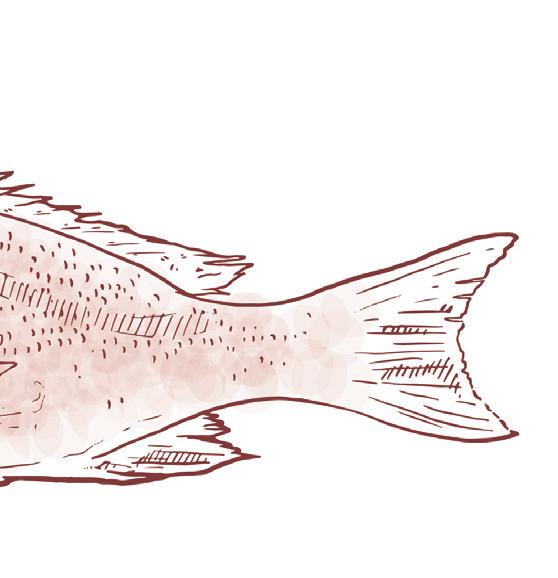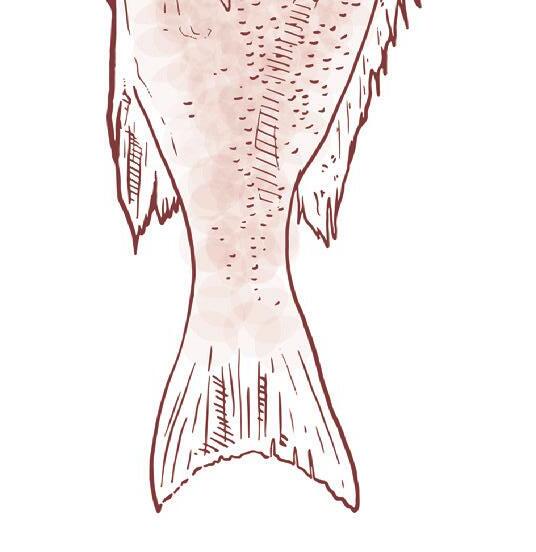






















It is with happy hearts and loudly growling stomachs that we present to you the Spring 2024 issue of Bite Magazine! This quarter, we sampled and explored many Chicago restaurants we’ve been excited to try: some popular and critically acclaimed, some just as good but a little off the beaten path. One graduating EIC finally traveled along the long, winding path to the culinary mecca of Alinea and was floored (8). Others found their way eating southern comfort food at the Delta (4) or upscale pork and tiramisu at the famous Purple Pig (11). Interested in traveling a bit, getting out of your comfort zone? We ventured up north to sample the freshest, melt-inyour-mouth oysters and crab you’ll ever find at Half Shell — and at the best price (12). Still hungry? We scoured the streets to really put those Tik-Tok corn dog reviewers to the test (6). If you’re intrigued by the thought of cereal and meat put together in a single dish, then this corn dog crawl is for you.
We became extremely interested in rethinking food traditions which have persisted for centuries, for millennia. We revisited the typical baseball snack (18), lamented on the comic, quotidian tragedies of food allergies (14), and reflected on meat consumption and new alternatives (16). We even took Bite inside a traditional Chicago confiserie through reflecting on a behind-the-scenes opportunity at Katharine Anne Confection one of us was able to experience this quarter (20).
We also worked hard to whip up some delicious dishes that fit the spring mood. To get through the day with hearty and protein-filled meals, try our three egg vignettes, sworn to impress at any breakfast, lunch, and dinner (22). In the mood for eating fusion? We’ve taught you how to make carne asada musaka right in the comfort of your own home (25). If you’re feeling up for a little dinner, whip up a little seared red snapper (26). If you’re looking for a dish that will make your apartment smell of sugar and happiness, try our scrumptious frosted snickerdoodle bars (24).
As we go through spring and prepare for the warmer temperatures of summer, we are excited to continue exploring all that Chicago has to offer. If you’re looking to get out and explore the culinary scene, boy, do we have the recommendations for you. No matter what you decide is in your foodie future, don’t forget to scroll through our Instagram (@uchicagobite) and tag us with all your epicurean adventures!
4 The delta 6 Corn dog crawl 8 AlinEA 11 Half Shell 12 Purple pig 14 Living with a Nut Allergy 16 Lab-grown Foie Gras 18 Food and Sports 20 Day in a confiserie 22 3x egg recipes 24 frosted snickerdoodle bars 25 Carne asada musaka 26 Red Snapper
CO-EDITOR-IN-CHIEF CAYLA VOLANDES
CO-EDITOR-IN-CHIEF KALLIE HOFFMAN
MANAGING DIRECTOR Aidan cessor
CREATIVE DIRECTOR ALLY GAMMILL
PROGRAMMING DIRECTOR STACIA KONOW
DIRECTOR OF FINANCE IAN B. HENDERSON
BLOG EDITOR OLIVIA SHANLER
DESIGNERS Abbey Piatt Price, Ally Gammill, Amelie martin, Ana Estupinan, Audrey Kaye, Emily Son, Julie Kang, Ningjing Huang
WRITERS Abby Yuhan, Aidan Cessor, Cayla Volandes, Charlotte Engrav, Connor Bloch, Ian Henderson, Kaia Griggs, Kallie Hoffman, Karina Mak, Ky Cruz, Olivia Shanler, Oscar Chen, Riley Yates, Zoe Kim
PHOTOGRAPHERS Karina Mak, Emily Kim, Phoebe fingold
COVER PHOTOS KARINA MAK











































RANGOONS




























CHICKEN BISCUIT SANDWICH

As part of a new initiative at Bite this quarter, we partnered with a local Chicago restaurant, The Delta, in Chicago’s Wicker Park neighborhood. The aim of this partnership was to cultivate deeper relationships with chefs, restaurateurs, and the people that make Chicago a dynamic culinary oasis while also using our platform to advertise emerging restaurants and chefs. Myself and eight other members of the Bite team spent an entire afternoon eating, drinking, and engaging in thoughtful conversation with the Chef, Sous Chef, and Pitmaster at The Delta.




Upon arriving at The Delta on a brisk Saturday in February, we were greeted by a lively bar with pop music loudly emanating from the overhead speakers. This environment contrasted with the cozy alcove in the back of the restaurant where we sat down for a late lunch. The warm lighting and wooden tables created an environment where large groups could spend hours chatting, drinking mimosas, and devouring comfort food. The restaurant has a muted and calming aesthetic, but




















it can quickly shift toward a dance club when Drake starts playing at full blast. It is a restaurant that aims to serve its community as a reliable neighborhood café, a lively bar, and a place to try out innovative dishes from an experienced chef.








After being seated, Chef George brought out tamales, corn fritters, and fried chicken. The tamales were filled to the brim with beef, which established the tone that The Delta is a place where one goes to be taken care of and leave fully nourished. The beef’s flavor was slightly muted, but the dish was just the right amount of richness. The corn fritters, which are one of many vegan options at the Delta, achieved a wonderful textural balance between a crusty exterior and a creamy inside. This balance of textures was lacking in the fried chicken, which also had a slightly difficult to decipher medley of spices. I expected a more classic southern fried chicken and this dish repositioned my understanding of The Delta.









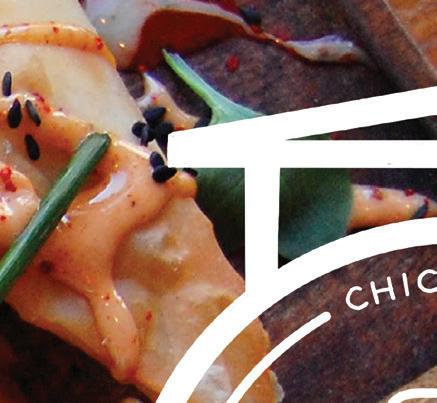





During our interview with Chef George, we learned that he does not aim to fit his restaurant into a certain mold or cuisine. For diners, this means that flavors from African, Chinese, Italian, and Mexican cuisines will all be on display. This can be slightly difficult to grasp for a first timer as it is hard to place the restaurant within a category, which can make ordering with friends around a specific cuisine or style both challenging and complicated. Many southern staples can still be ordered such as red beans and rice, cornbread, and biscuit sandwiches, but no one was complaining when Crab Rangoons were brought out alongside them. All of these dishes are incredibly hearty and perfect for a meal in the winter. A phrase that our group kept coming back to when describing the Delta was “unrefined in a homey and comforting way.”





this idea through his generosity, his passion for cooking, and his focus on cultivating a diverse and supportive community in Wicker Park. The Delta creates a sense of belonging for members of the community in the same way that fans of an artist feel bonded via their shared adoration for a larger-than-life figure.
For us at Bite, this afternoon reformed how we think about the role of our magazine within the UChicago community. Our responsibility is not solely to review restaurants and talk about our love of food. Instead, we can also become a powerful bridge between a diverse student body and the many chefs that make Chicago the special place that it is. We would recommend the Delta to anyone who wants both a nourishing meal and that has a desire to better understand the power that food has to shape a community. In the future, we hope to introduce UChicago to more people like Chef George.


Chef George is a personable, selfless, and resilient restauranterer. During the Covid pandemic, he spent time and money to provide food to his employees and members of the community. Moreover, he sees the identity of a chef as forever changed by the pandemic and the economic uncertainty that many Americans face. In our conversation, he described that “the chef is the new rockstar for society.” Chef George embodies


































































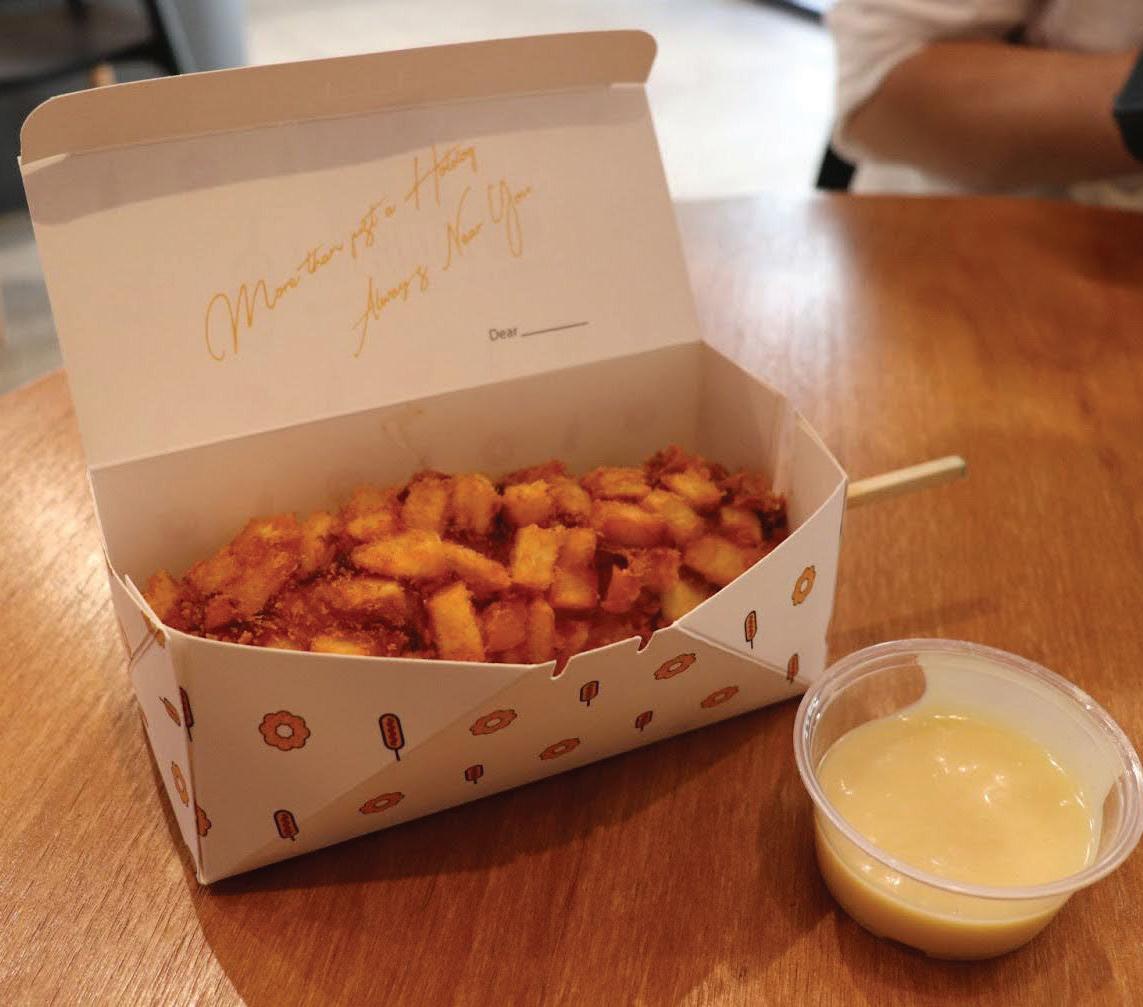
Corn dogs have been a staple of street food in Korea since the 1980s due to their portability, competitive prices, and accessibility to picky eaters and food lovers alike. In 2016, Myungrang Hot Dog — a hot dog restaurant outside of Busan — opened its doors and revolutionized the snack, elevating it from the familiar American treat to the cheese-filled, potato, Cheeto-dust, or Fruity-Pebble encrusted morsels you’ve surely viewed on your Tik Tok or Instagram feeds. In 2018, Myungrang opened an exceedingly popular location in Georgia, its first in the United States. It was followed up in 2019 with a spot in Los Angeles that was forced to set a 5 corn-dog-per-person limit. In summer 2021, the trend reached its peak, with Korean hot dogs available essentially everywhere and with extremely high viewership on social media. Since then, the buzz has died down, but many chains remain scattered around big and small cities alike — there is clearly still some audience for the indulgent treats.
For this quarter’s crawl, we wanted to check the pulse of two popular Korean corn dog chains, to see if the over-thetop bites stand the test of time and crown one the definitively better spot.
Mochinut
We started our crawl at Mochinut on Michigan Avenue. While there are multiple locations throughout the city, we chose the little shop at 328 N Michigan. Decorations like the faux
cherry blossoms and a wallpaper depicting the city made it an aesthetic eatery. We decided on a half and half corn dog (beef and cheese) with potato coating and honey mustard sauce. Coming in at a little over $8, the price was well gauged for the gaudy item, but was it worth the trip?
Ky: This savory dog was packed with flavor. The fillings were exactly what you’d expect — a sausage and glorified cheese stick. What stood out to me most was the potato outside. It presented a mouthful of French-fry-esque taste with every bite. For how well the flavor combination seemed, I felt the potatoes overpowered the cheese half and worked best with the beef. As for the sauce, it was a run of the mill honey mustard, but that’s not a bad thing — it only added to the palate.
Charlotte: I appreciated the freshness of the corn dog. At county fairs and Disneyland, corn dogs sometimes look and taste like they’ve been laying out all day, slowly going stale under the warmth of orange heating lamps. Mochinut’s dog was bitingly hot, extremely crispy, and well-balanced in flavor and texture. The breading mixture had a light sweetness to it, which really enhanced the saltysavory flavors of the cheese and hot dog sections. I’m not a honey mustard girl, but I found the sauce important in adding depth to the flavor profile, as well as a lightness that broke through the heavier warmth of fried dough, hot dog, and melted cheese.
With our first stop out of the way, we took the bus down the street to Kong Dog. Located at 200 S Michigan (again, one of a few locations in the city), the slightly larger store was… strange. Adorned in Route 66 and King Kong paraphernalia against black and yellow wall, we found it felt more like a Hertz car rental rather than a restaurant. Interior aside, we went for another half-and-half dog (beef and cheese) with a Fruity Pebble outside and ranch dressing for about $9 after tax.
Ky: I’ll start with the fillings since they were identical between our orders. I preferred Mochinut’s beef to the flatter flavor here, though the cheeses were on equal ground. Our choice of the sweet outside absolutely played better with the more neutral cheese. Rather than overpowering, I found myself able to enjoy both the sugary cereal and the melty half of the inside. In hindsight the ranch was a strange choice on our end, but the quality of the sauce was especially poor. I wouldn’t recommend it regardless of the dog you choose.
Charlotte: Bouncing off of Ky’s point, the ranch was a major ding on the Kong Dog corn dog — unlike Mochinut’s fresh honey mustard, it was a shelfstable Heinz packet of ranch that had not been refrigerated and arrived entirely separated. Giving Kong Dog the benefit of the doubt, I stirred it up and tried it on a bite — it was okay, but nothing special nor worth the suspicious appearance. My one remark about Kong Dog that really lowered its score was the thickness of the batter and breading. Where Mochinut
had an effective amount, Kong Dog’s felt really enveloped in already-sweet batter, sweetened even more by the Fruity Pebbles coated liberally on the outside.
Charlotte: If a friend of mine were in town traveling down Michigan Avenue and they had to pick between Mochinut and Kong Dog for their mid-afternoon tourist snack, I’d recommend Mochinut.
Aside from the better quality of the corn dog, better value, and more aesthetically pleasing interior, Mochinut also has a wide variety of beverages, along with its more well known mochi donut.
Ky: Surprisingly impressed as I was at the sweet rainbow outside offered at Kong Dog, I have to agree with Charlotte that Mochinut is the better spot. Their overall superior quality coupled with pricing and variety leaves competition at the car rental.
https://www.thrillist.com/eat/nation/koreancorn-dogs
https://www.bonappetit.com/story/korean-corndogs



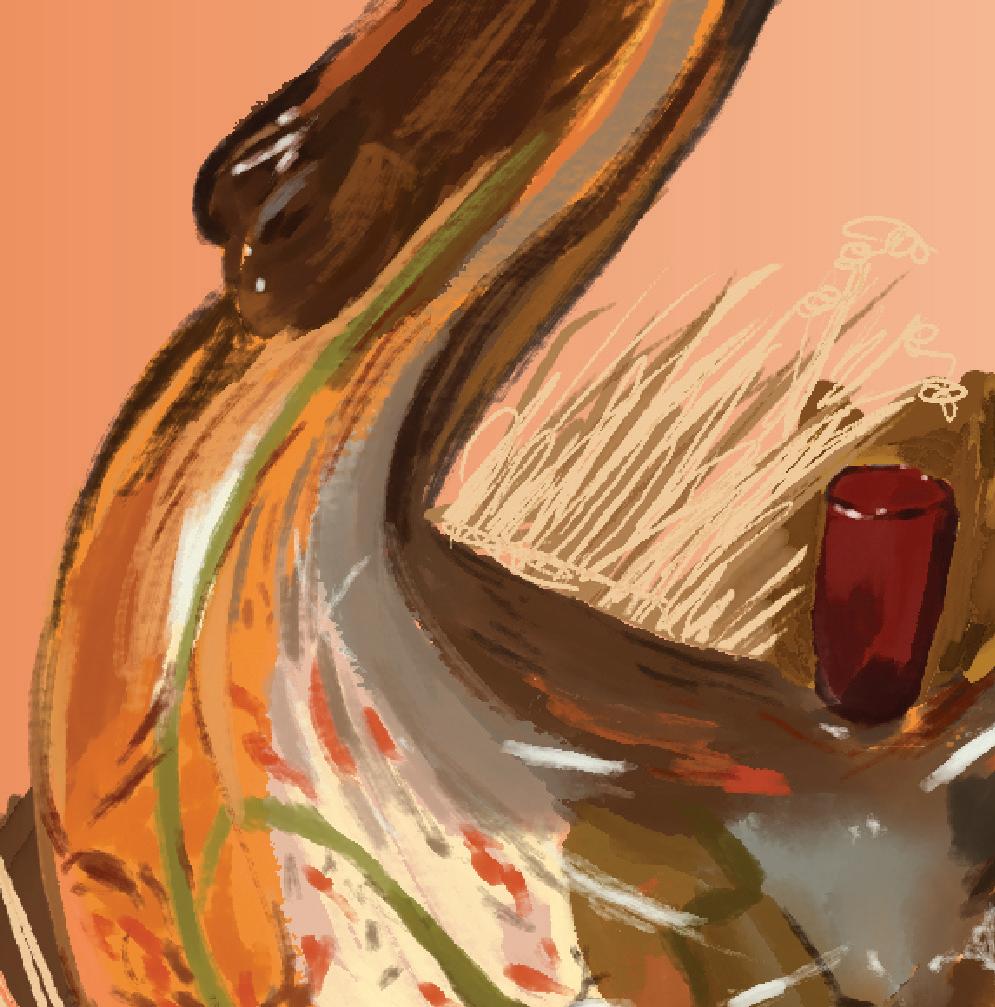

>> DISHES TO TRY CHEF’S TASTING MENU

Why is there a ceramic rooster sitting atop a bed of hay in the middle of our table? “I’m not going to tell you yet,” our waiter responded to my question of the reason behind the centerpiece. Perhaps the course associated with this artwork would contain chicken, resemble chicken, or come from a chicken — who knows. Alinea’s motto? “It should all make sense shortly.”


Alinea’s history begins with Chef Grant Achatz, Michigan-born chef and one of the pioneers and leaders of molecular gastronomy. In 2005, its co-owners Nick Kokonas (former CEO and co-founder of Tock) and Grant Achatz launched Alinea. As it gained repute, by some twist of malicious irony, Achatz was diagnosed with stage 4 tongue cancer in 2007. He underwent chemotherapy with questionable odds of life but by 2009 was cancer-free and began to regain his sense of taste. Despite all of his personal ailments, by 2010, Alinea had been awarded three Michelin stars. Both Grant Achatz and Alinea have been awarded James Beard Foundation awards multiple times. For God’s sake, there’s an Alinea Wikipedia page and a Britannica history page on Achatz. Today, every foodie in the world knows about Alinea. I was no exception.

When I began my journey at UChicago, I set a goal, or, one might say, a date, in my mind. I had heard outlandish stories, fantasies, tales of the Alinea experience, but knew it would have to wait until graduation. I needed to end my stint as Editor-in-Chief of UChicago’s culinary magazine with a bang and in proper form: by going to the end-all-be-all restaurant of Chicago. The trials and tribulations of financial accounting and job recruiting would need to be complete; Alinea would need to be saved for the celebration of the closing of my current chapter and the opening of a new one.
Our car pulled up to a gray, bleak, unidentified building. No signs, no lights, nothing. “This has to be it,” my Aunt Stell and I said to each other. As a regular menu stalker and food-obsessor, I usually go into a meal knowing my order. I read Infatuation and Eater, scroll through Beli, and have a general idea of what the restaurant is known for. But here, I completely surrender myself to the whims of Alinea. We


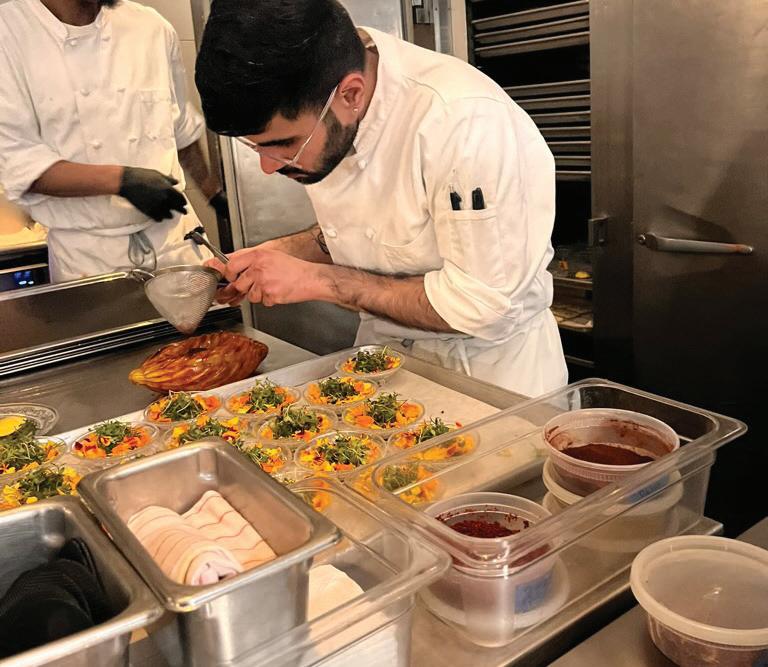
were there for the journey, the adventure, and going in completely blind. Walking in, the hosts embraced our arrival warmly and jovially, immediately easing our intimidation of the expedition on which we were about to embark. After the hosts led us to our seats at the edge of a long, communal table with multiple candelabras dotting the otherwise dimly-lit and mysterious interior, Aunt Stell and I nervously found our seats.
At the table, a shiny, lacquered plate laid in front of me, with hand painted golden stars cuddling next to baby angels. The cheerful aesthetic, angels’ soft smiles, and overall craft of the piece renders the plate comforting, welcoming, and ornate — another tactic to soothe the anxious eater. Next to our plate, meat flies on a stick, resembling a sort of flag, next to an artfully placed napkin with a stark black Alinea stamp on the white linen. We sit next to strangers and watch a woman miles away at the other end of the table stir a large silver pot. Attendees are encouraged to ask questions upon confusion, curiosity, and everything in between. But don’t ask about what’s to come next: the inevitable reply will resemble something such as, “wait and see.”
We were not simply at the dinner table, we were in an art gallery. At the center of the ovular shaped room, there was a hanging, undulating art installation with food perched upon it which resembled… donuts? But surely they wouldn’t be donuts, I thought to myself. It’s too early for dessert. Throughout my experience at Alinea, I kept considering how each piece comes together. The angel plates, the meat flag, the donuts. What is the purpose of each and every miscellaneous item?
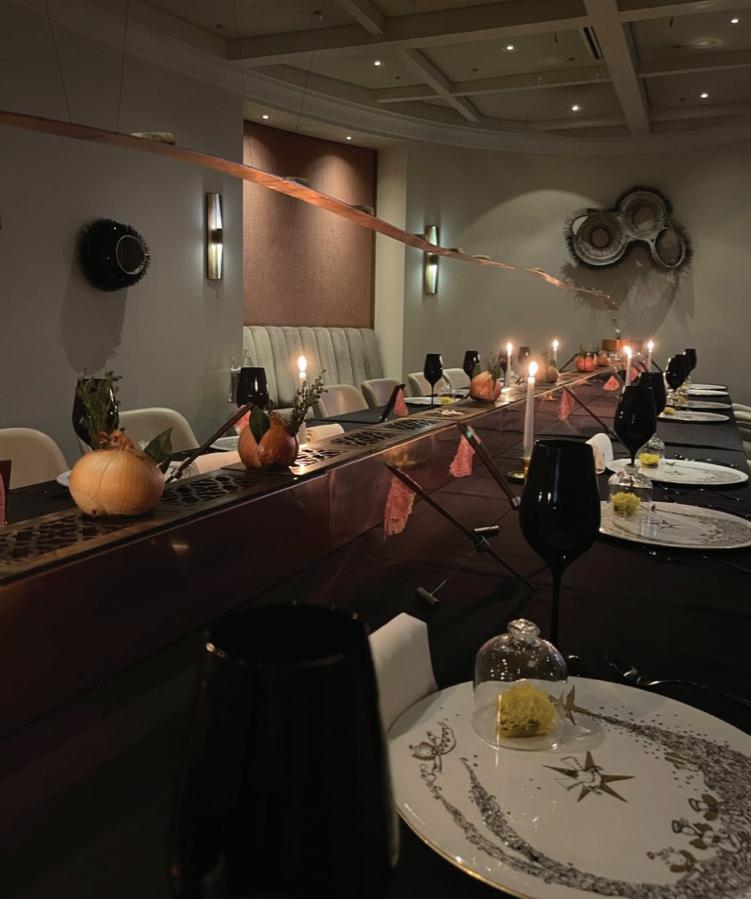
As more diners trickled in, Aunt Stell and I overheard conversations with the hostess on why they chose to spend their Friday night at Alinea. Everyone was celebrating something: a graduation, an anniversary, a birthday, a promotion, you name it. This experience is meant to be saved and savored only at a special time. While the price tag influences this, the curation of the experience itself is what makes Alinea stand out over other Michelin star restaurants or restaurants similar in price. Its approach is personalization and curation. Each diner leaves with a personalized menu of what they ate that night, based on dietary restrictions, the courses selected, and if a wine pairing was included. Not only do you celebrate something special by being here, you are special yourself.
The conversations came to an abrupt halt as sudden fierce classical music flooded the room; the waiters took their places. Knights (waiters), draw your swords (chalices). The Alinea staff wore black head to toe, bringing and clearing each plate with the swiftness and velocity of a ninja, some sort of secret agent. The waiters triumphantly held a torch carrying a flame fitted with rope encircled around the long stick. They rested their fiery torches on the table and let the flames take. The bronze grate in the middle of the table morphed into a fireplace, and the table was lit aflame. While the torchbearers exited, other waiters entered carrying vessels resembling crockpots to be heated by the flame. There were also multiple whole, raw onions lying in the center of the table. As the flames engulfed the helpless alliums, the new waiters poured from the table-heated crockpot into my bowl. As I took
bites of this exquisite french onion soup, I could smell the onions roasting in the middle, which also took part in the dish. There is an appreciation for the five senses at Alinea — a crucial tenet of molecular gastronomy. Even the donuts — in reality cheese brioches — were heated using the tendrils of the flames. Like a scene from the Middle Ages, we found ourselves sitting in plush, velvet chairs and watching the fire burn in the hearth. In this section of the meal as in most others, Alinea pays homage to how culinary traditions of the past all started: with a flame and an idea. Each plate in Alinea is no accident; it is strategically and artfully crafted to make the audience think. We were not only there to eat a delicious meal. We were there to see how food can have a history, idea, art, and meaning behind it. We finish the first step of our culinary journey after slurping on french onion soup, munching on cheese brioche, and nibbling on a deconstructed iceberg lettuce salad. The hostesses then warmly invite us inside the kitchen — gasp, a treat I couldn’t have imagined being gifted. If you’ve read Kitchen Confidential, you have an idea of what a restaurant kitchen looks like. It’s madness: a line cook is in the corner bleeding after cutting himself slicing a pork tenderloin while screams erupt from one side to the other. “Meat dish for table 75 is gluten-free,” “where’s the goddamn cilantro,” “why hasn’t the bread from Amy’s been delivered yet,” and everything in between. On the contrary, what I heard in the Alinea kitchen was a low hum of rhythmic clicking and scurrying, like I walked inside of a machine. Which, essentially, it was. Alinea’s kitchen leaves no room for
error. Chefs place each aspect of any dish with tweezers and carefully move and shift each piece until it is just perfect. Sifters, tweezers, and multiple other obscure kitchen gadgets were both being used and line the walls inert. Each kitchen table focused on one course, with multiple hands and helpers assembling its parts. The best part about all of it? We saw Achatz himself, strolling through the kitchen with a calm, quiet demeanor. Every dish is approved by him before it is sent out to the world.
On a kitchen table, twenty plates with an orange treat lay out waiting for us. This course’s culinary maestro, fitted with a clean-cut button down, explained it was a cornbread bite with a crab crudo atop. He strongly recommended that we finish it in one bite. The crab was fresh and with a cool temperature and smooth texture went down easily. Spices were present but not overpowering, allowing the crab itself to pull most of the weight. Underneath was a little pop of moist cornbread. To pull from Achatz’s Instagram, the exact ingredients of the crab cornbread bite included king crab, cornbread, celery, and a yellow tabasco sheet. Each sea creature is pan fried in butter, topped with crab mayonnaise flavored with celery seed.
In front of me stood an “Alinea Achatz Style Corn” popcorn machine with bold, colorful lettering that popped fresh popcorn as we heard the kitchen’s bartender explain the story behind the upcoming drink he and a team concocted for us. Even the popcorn, a treat which can be difficult to beautify, was unique — a southern-tasting profile of spices, with flecks of red and black, made the popcorn addictive. Exact ingredients, again pulled from Achatz’s Instagram, included a bowl of jimmy red popcorn with butter, chilis, sugar, and
salt. It wasn’t heaps of butter that made the popcorn delicious, which is usually the case, but Achatz’s and Alinea’s craft and ability to manipulate and subvert all conventional ways of “doing food.”
In addition to the Alinea popcorn machine, also at the center of the kitchen table was a large silver pot emitting puffs of smoke which enraptured the focus of the party. No one had any idea what was going on: while we were strangers before, we were united by the common experience of being in the dark. The bartender explained the purpose of the pot: to craft the signature cocktail, which is named “Yellow on Mellow.” A riff on a Bloody Mary, this drink contains yellow tomato, passionfruit, and base seasoned with galangal juice. The two alcoholic substances are Mellow Corn, a type of corn whisky, and Nixta Licor de Elote. No, it wasn’t not done: each drink was topped with popcorn bubbles. I am not a sommelier, neither in profession nor passion by any means. While this cocktail wasn’t necessarily my favorite — as the eccentric taste of sweet corn and alcohol is clearly a choice — it was different. Chalices and a goblet containing a unique corn cocktail? You don’t see that everyday.
To go through and categorize and detail each dish of what I experienced at Alinea would require far too many pages to give it justice. It also wouldn’t be fair to leave each and every stone overturned for those waiting to experience Alinea’s magic and mystery for themselves. In general, each piece of food I experienced at Alinea was a gastronomic masterpiece. Often I found it difficult to describe what I was tasting and seeing using my available vocabulary. The constraints of the English language were weighing me down in my ability to truly express the complexity of
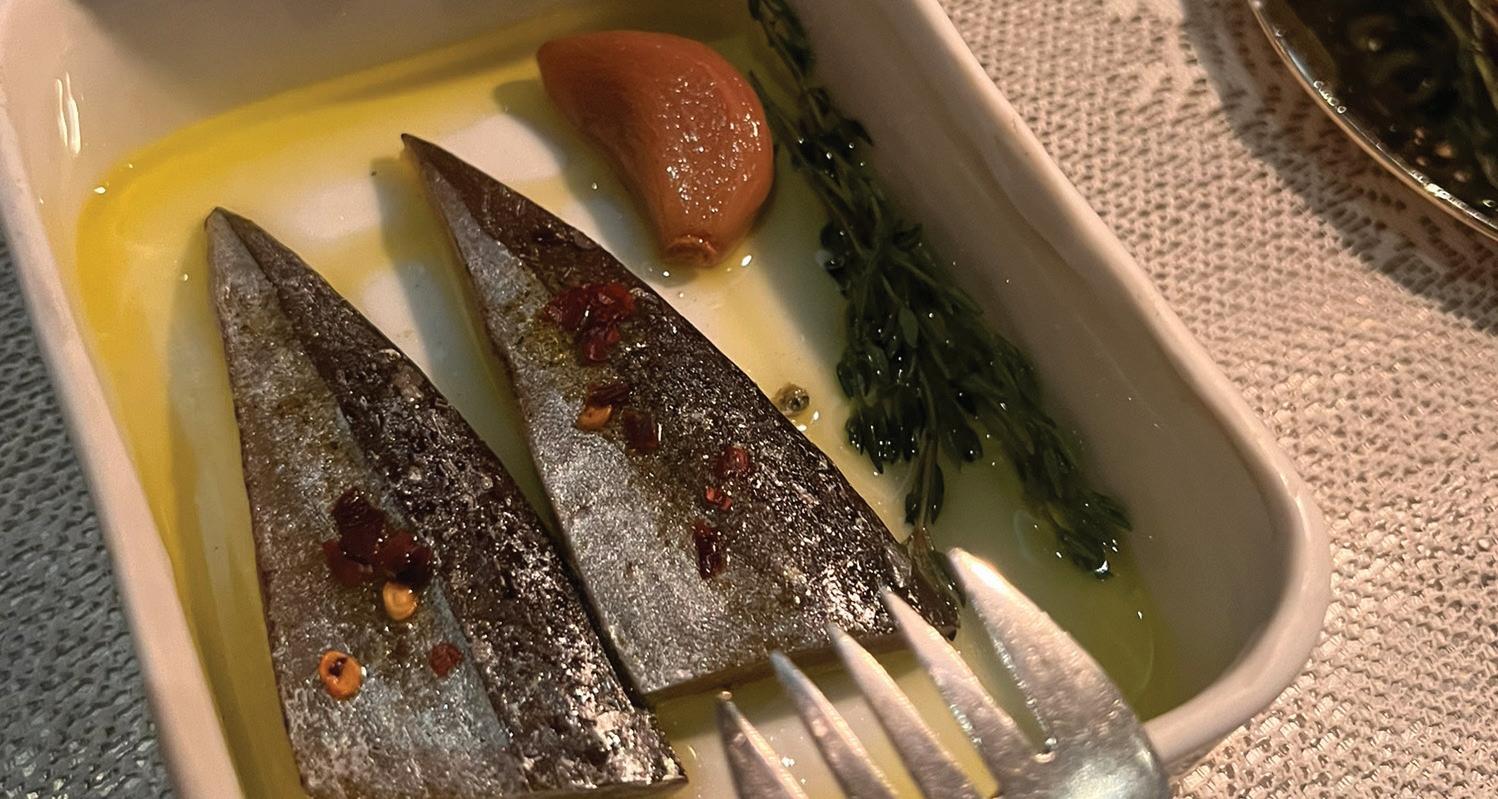



tastes, textures, visuals, and mouthfeel. To conclude this tale, I offer one last tidbit which I feel is emblematic of Alinea. In the middle of our meal, I clocked that each table was not only fitted with a Medieval-like candle, but also with an old-fashioned sardine box. I shuddered in disgust. I’ve tried the small fish multiple times throughout my years, each time believing my palate would be advanced enough to handle the pungent taste, and each time I am disappointed. When the time came to finally consume the dish, our waiter opened the box to reveal… sardines? No, he explained. Each “sardine toast” consists of eggplant, rye toast, herb salad, and butter. The eggplants are pickled, cured, and then sous vide to achieve the appearance of a herring. I am wowed: Alinea continues to impress as a master of manipulation, mystery, and illusion. Just like the fire and the hearth at the beginning of the meal, we again see Alinea tied to history: while sardines resting in their extravagant boxes were a status symbol in the 1900s, sardines in the late 20th century were seen as the poor man’s “dirty dish.” This humble ingredient making an appearance in haute cuisine shows the restaurant’s dedication to remembering culinary origins. I take a bite into the rich eggplant toast and chew slowly, savoring the complexity of the amalgamation of flavors. While these slices almost exactly resembled sardines, “That would be too easy. We need to Alinea-fy it.”






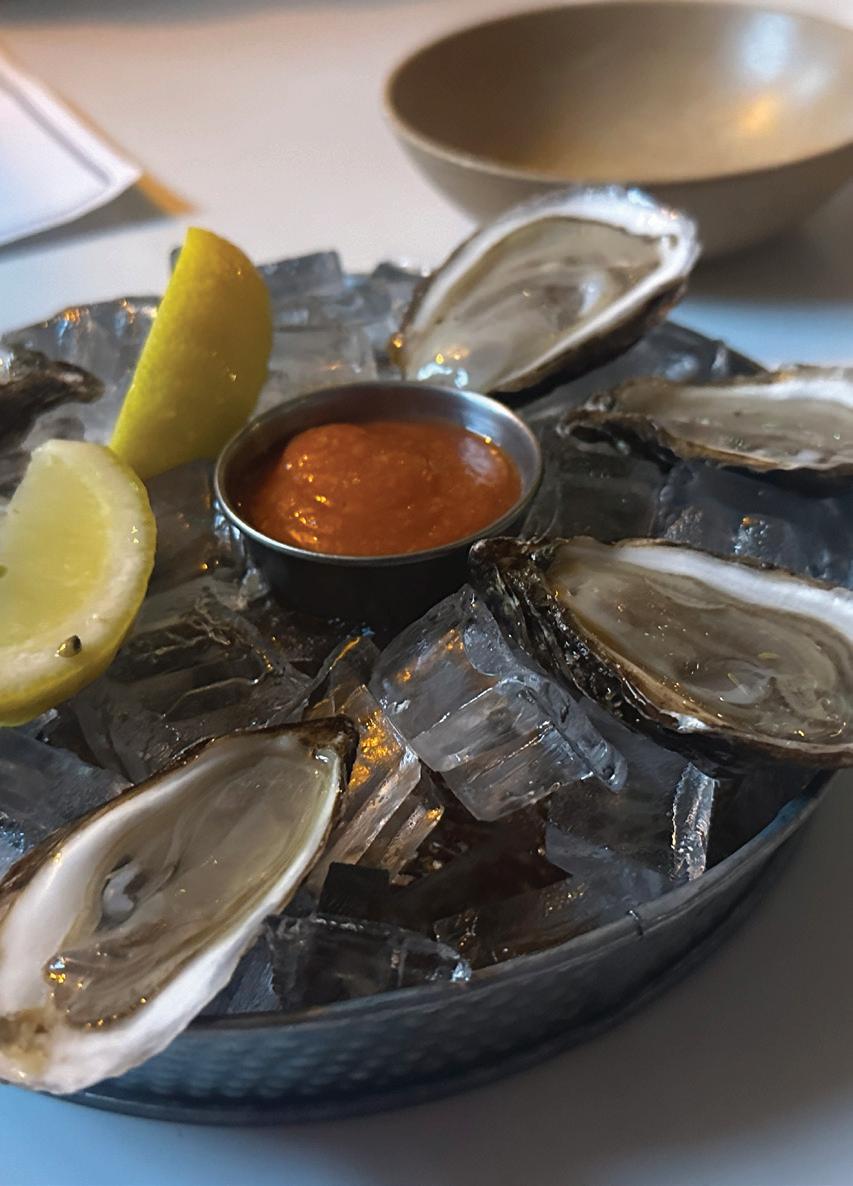






There’s an old tradition of oyster season being the months with the letter ‘R’ — from September to April — to avoid watery shellfish or nasty food poisoning. So when March and April passed by at a signature 2024 pace, I developed a last-minute craving for the delicacy. That’s how I came across Half Shell, a (literally) underground, family-owned oyster bar located in Lincoln Park. While the surrounding neighborhood itself is quaint and mellow, the real excitement is a story about Half Shell’s fresh seafood menu that introduces quality seafood to ultra-casual dining. Gone are the days of weeks-long reservations, stuffy dress shirts, and all the woes of fine dining that seem to gatekeep fresh seafood. Finally, I had found my reservation-free, cash-only, underground gem serving snow crabs, frog legs, and $12 per dozen oysters. Was it too good to be true?




It was hard to tell at first. After all, Half Shell wasn’t one for fancy table tops or lobster bibs. It lured you in with the comforting dimness of a neighborhood watering hole. Festive lights adorned the ceiling, a baseball game played on the TV, and next to all the hearty chatter, you could see the daily market value prices for all of today’s fresh finds. As I settled into one of the worn-in bar stools, I knew I had to try the oysters first to truly get a sense of the seafood quality. The freshwater oysters were served cold on the half shell, alongside lemon wedges and cocktail sauce. What stuck out to me was that the oysters were inconsistent in size, with some being larger and plumper than others. Despite the varying sizes, the oysters were remarkably fresh, briny, and flavorful. And with my oyster craving now sated, I could

now focus on the crustaceans.


Beyond oysters, the menu featured a king and snow crab combo. The dish was “no-frills”: a generous, steaming heap of crab legs served with a drawn wasabi butter sauce and lemon wedges. To get to the meat, you had to work for it, cracking and breaking down legs with hands, teeth, and a trusty crab cracker. It’s safe to say the effort made it all the more worth it when you’re rewarded with tender and briny crab meat. To balance the saltiness of the crab, Half Shell’s wasabi butter created a richness that gave the crab a kick while drawing out the natural, fresh flavor of the tender meat itself. Nearly all of their sauces included hints of wasabi that hit the palette with a refreshing after-feel that seafood so often needs.
I applaud Half Shell’s commitment to showcasing the natural flavors of fresh seafood; it delivered seafood straight with balanced flavors. The modest, ultra-casual setting made room for everything else to shine: lively conversation, good company, and fresh seafood. So the next time you crave your favorite mollusk, grab a couple friends (the ones whom you can confess your seafood secrets to) and enjoy the oysters and vibes down at the Half Shell.










ExecutiveChef Jimmy Bannos Jr, the 2014 winner of the James Beard Rising Star Chef Award, brings hype and prestige to the Purple Pig, a well-known Mediterranean bistro on Michigan Avenue tucked into the lobby of a downtown office building. Upon entering, the Spanish-style decor made it obvious that there was an attempt to create an elevated atmosphere. Unfortunately, the harsh fluorescent lighting of the office building lobby — which was visible from every table in the restaurant — intruded on an otherwise warm and welcoming atmosphere. We put in our orders and waited to see if the hype around this restaurant would live up to expectations. Spoiler alert: it did not.
We started off with the Burrata and Bone Marrow appetizers. The Burrata was gooey and fresh, topped with a savory beet, olive oil, pear, and pine nut salad. While the accompanying grilled toast points were crispy enough, they were dripping in oil, and the overall dish lacked acidity, so the flavors felt unbalanced, and the execution clumsy. Next, we had the Bone Marrow, which is one of the restaurant’s most well-known (and constantly photographed) dishes. The serving was large, and the perfect delicate, spongy tissue of the marrow paired well with the light salad of parsley and thinly-shaved white onion, as well as fresh butter and flaky sea salt. Unfortunately, this dish also came with the same greasy toast points as the Burrata, creating an overall effect which made the dish too heavy.
I was excited for the Ravioletto with crescenza Cheese, truffle, rosemary, garlic, and porcini Mushroom Sauce, but it ended up being the most disappointing part of our meal. For $24, I expected a large serving of hearty Ravioletto, topped with a sumptuous and savory truffle brown butter sauce. What I received, however, was the opposite: a paltry serving of pasta swimming in a burnt butter pool, which, shockingly, still made it to our table. Overall, this dish was a complete let-down in terms of flavor, as we tasted no truffle, and in my opinion, was also a waste of money.
Fortunately, our next dish was the Pork Belly, which was the highlight of my meal and the saving grace of this experience. The pork belly was delicious, succulent, and had the ideal melt-in-your-mouth texture. The espresso added a subtle bitterness to the dish that paired well with the bright ginger glaze, and the frisée salad with pickled carrot and radish was the perfect light component to balance the rich pork belly. This dish was an all-around favorite, and a masterclass in texture, flavor, and execution. I would return to the Purple Pig if only for this pork belly. Feeling slightly uplifted after the delicious pork belly dish, I greatly anticipated the pistachio tiramisu we ordered for dessert. Pistachio is one of my favorite spring flavors, and this dessert played with it beautifully. The addictive vanilla bean crème anglaise paired well with the raspberry gelée, and the crunchy pistachio topping added textural contrast to tie everything together.
While this was not an outstanding dining experience, if I came back, I would structure my menu a bit differently. I would be curious about sampling more of the pork dishes, such as the Crispy Pig’s Ear, Smoked Pork Tongue, and the Pork Ribs. My expectations were not met by this experience, and I think that for the price point, this meal was quite disappointing. I expected to have a flawless experience for the amount of money I paid, yet I received sloppy and partially executed dishes that lacked attention to detail. Still, the presentation of the dishes was welldone aside from the Ravioletto, so I can understand why this restaurant became popular on social media. Given the amount of media coverage and the price point at the Purple Pig, this should have been a highquality and enjoyable meal. Instead, it stuck out for the wrong reasons. Giving the Purple Pig the benefit of the doubt, perhaps I simply ordered the “wrong” dishes from their rather large menu, or maybe it was just a bad night for the kitchen staff. Hopefully, any future visits I make to the Purple Pig will turn out differently.
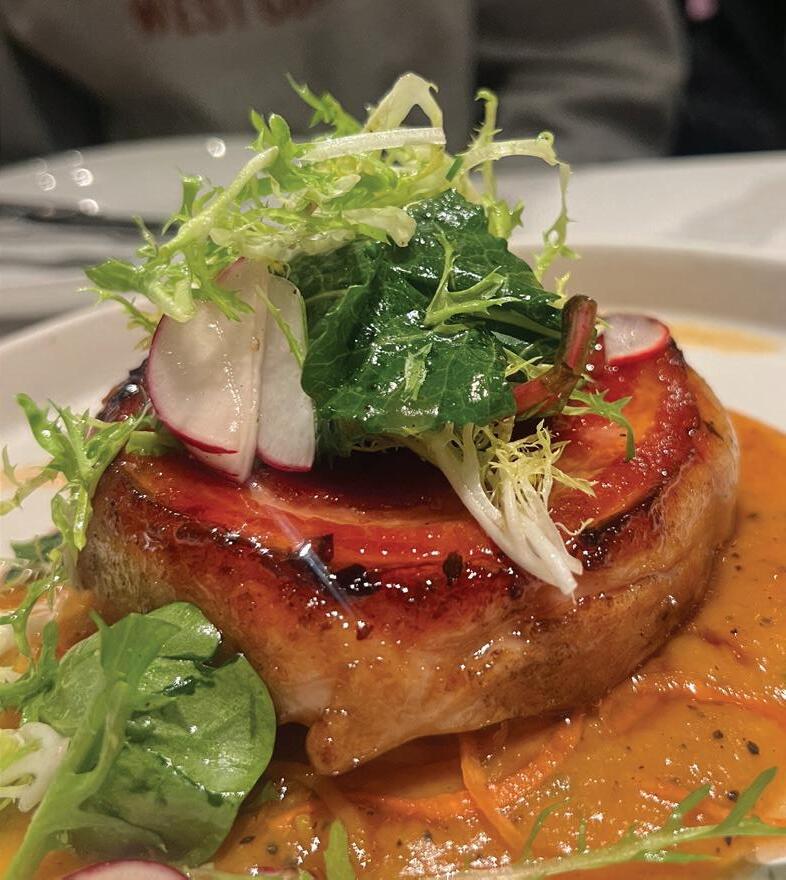

>> NEIGHBORHOOD
THE LOOP
>> PRICES
$$$
>> DISHES TO TRY
PORK BELLY
PISTACHIO TIRAMISU








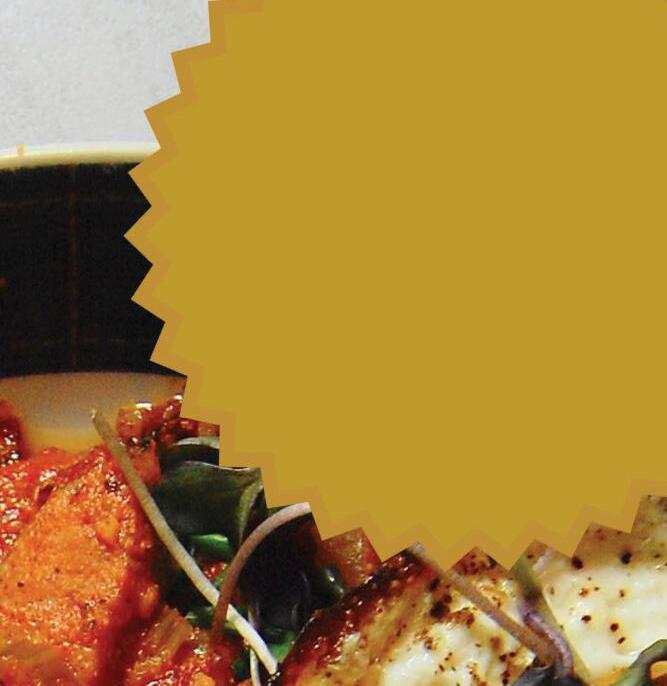












































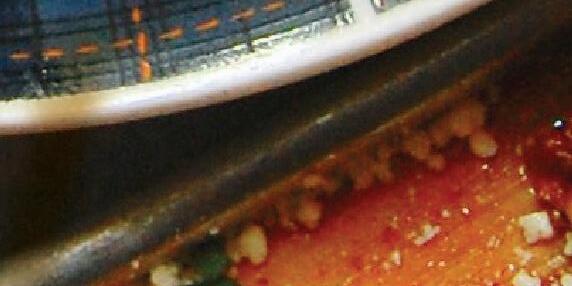
















I am a person living with a tree-nut allergy.
There, I said it. I have a lifelong label that I have to report to academic institutions, on any field trip, or really any instance that involves food. I have to live with the shame of being a “weaker breed of human,” as some of my friends might say, and the embarrassment of being the one person who has to list all of their allergies when ordering at a restaurant. Which is why, oftentimes social situations are often the most stressful part of having an allergy.
Navigating the social stigma of a nut allergy comes with many challenges. Cue the common,
“You have a nut allergy?!”
with looks of pity, followed by questions about all of the foods I cannot eat: nutella, pecan pie, pesto, trail mix, and baklava, to name a few. There’s also the obligatory,
“So, like, what happens if you eat them? Do you have an Epi-pen?”

inquiries from well-meaning acquaintances, followed by the inevitable horror stories of that one time someone’s friend had a mild allergic reaction to a pistachio. We can’t forget about the retelling of traumas that my friends have from that one time they accidentally fed me nuts (I somehow risked my life for the taste of macadamia-crusted fish in high school and Rocky Road ice cream on a drunk night out).


The most embarrassing part of having a nut allergy is having an allergic reaction. Pretending I am not going into anaphylactic shock when I am at work or in front of people I don’t know well, is possibly one of the most difficult things to fake. And reassuring people that I am not actually going to die because I ate a pecan in a salad, but still having to alert people that I may need Benadryl as soon as possible, is quite difficult to explain when the reaction is already happening.



can it be that allergies only arise in people in America
lution, dietary changes, and less exposure to microbes, which change how our immune systems respond” (BBC, 2019).
To summarize, living with a nut allergy is an ever-changing journey. From navigating the grocery aisle, to dining at restaurants, to anxiety-inducing social situations, a nut allergy (or any allergy, really) can often be all-consuming. Allergies are also extremely misunderstood, both socially and in research. It takes input from those who are affected daily by these experiences of living in a nut-filled world, to bring attention to the challenges and misconceptions surrounding allergies. Perhaps my stories can help shed light on the realities of living with allergies, one tree nut-free day at a time.
Sicherer, S. H., Muñoz-Furlong, A., Burks, A. W., & Sampson, H. A. (1999). Prevalence of peanut and tree nut allergy in the US determined by a random digit dial telephone survey. The Journal of allergy and clinical immunology, 103(4), 559–562. https://doi.org/10.1016/s0091-6749(99)70224-1
Santos, Alexandra. (2019). Why the world is becoming more allergic to food. British Broadcasting Corporation. https://
Illustration by Abbey Piatt Price














Cruelty-free. Pasture-raised. Grass-fed. There’s an abundance of labels on the market now to indicate foods of a certain standard. In a time of increased awareness around the cruel practices in the meat and dairy industry, companies have started to label foods with various promises of “humane treatment.” Consumers want to know that the products they are buying are ethically produced — and it’s a growing concern, especially in the United States. Companies have caught onto the trend: everywhere you look in grocery stores, these phrases are proudly and prominently displayed on egg, dairy, and meat containers.
However, these labels are loosely defined and ill-regulated. These words are not promises, but rather euphemistic expressions to ease consumer fears of animal cruelty. Egged on by the rampant exposure to documentaries and exposés of animal mistreatment in the dairy and meat industry, people began to look for alternatives: a decade or so ago, new and exciting plant-based meats began to crop up on the market, shaping the beginnings of a meat-alternative movement. From soy replacements such as the Impossible Foods brand, to pea proteins like Beyond Meat, these companies attempted to fill the demand from customers turning away from meat. According to a survey from Deloitte, the alternative-meat market has managed to almost completely sway 47% of consumers who reported occasionally buying plant-based alternative meat1. That number is not too shabby. However, that number has plateaued in recent years, and only indicates a consumer who occasionally purchases plant-based meat alternatives. The firm left a sizzling critique of the stagnant statistic, stating “plant-based food is hot. Plant-based alternative meat (PBA meat) not so much.” Analysts have chalked the PBA industry’s failure to the simple fact that plant-based alternatives are just not close enough. And they’re correct — a Burger King Impossible Whopper just doesn’t hit the same as a regular one does.
In light of a stalling industry, a few companies have turned to a new solution that they hope will revolutionize how people eat: cultivated meat. Spotlighted as the “slaughter-free” alternative, cultivated meat refers to the practice of mass producing animal cells in bioreactors. It is meat, created without ever having to raise or slaughter a single animal. Instead, a small cell biopsy can, in theory, produce millions of pounds of meat. How? With the right conditions, cells constantly grow and divide, multiplying from a small sample to huge batches of meat that cultivated meat companies can then transform into things like foie gras. One company has made it their sole mission to do just that — Gourmey, a startup based in France, has made headway in the cultivated meat market by bringing foie gras from the lab to the table.
Foie gras has made quite an infamous name for itself: a delicious delicacy yet also notoriously unethical. Buttery and incredibly fatty, foie gras is duck or goose liver that has undergone gavage — a process of force-feeding the birds several times a day to increase the richness of the pâté. More
1 https://www2.deloitte.com/us/en/insights/industry/retail-distribution/future-of-fresh-food-sales/plantbased-meat-sales.html

than a dozen countries have already banned the traditional production of foie gras, and in 2022, New York City followed California’s example of banning its sale in restaurants. Foie gras is certainly not an animal-activist friendly indulgence, but Gourmey has produced a solution for the conscious eater. The company’s scientists harvest and mature duck stem cells in the correct environment to eventually produce a tasty cut of the rich meat.
As a meat eater myself, the idea of synthetic protein doesn’t exactly get my mouth watering. However, the CEO of Gourmey claims that his product has “already convinced several French and international Michelin-starred chefs.”2 Another company has taken tastings one step further: Supermeat, a pioneering startup, was founded nine years ago in the search to create cultivated chicken meat. The company held a blind taste test of their cultured chicken versus the real thing - sitting to judge was MasterChef superstar Michal Ansky. Upon tasting both the cultured Supermeat sample and the slice of real chicken, she was not able to correctly identify which was the synthetic protein. Assuming my taste buds aren’t anywhere close to MasterChef level, this test proves that they could likely be persuaded.
There are plenty of critiques to any meat alternative. Deloitte has claimed that plants shouldn’t pretend to be meat. Other critics have already begun to circle the cultivated meat industry. Researchers at University of California, Davis, have found that lab-grown meat’s environmental impact could be “orders of magnitude” higher than the industry it is trying to replace, since significant energy is required to run the reactors which house the cells. we can’t give up on innovative solutions to steer the consumer away from chickens, cows, and pigs. Refining the production process could give us an opportunity at cleaner, potentially slaughter-free meat. While a world where diners serve you a cultivated T-bone steak is still miles away, the opportunity to have tasty and completely cruelty-free meat offered in stores and restaurants is a glistening possibility.




2 https://techcrunch.com/2022/10/05/gourmey-grabs-48-million-to-keep-working-on-lab-grownfoie-gras/?guccounter=1&guce_referrer=aHR0cHM6Ly93d3cuZ29vZ2xlLmNvbS8&guce_referrer_sig=AQAAADEipnc2y0SM0AW7aDJp5kYwbD1nwhdf1Pb40iQolBiAjCqVOwyPnPTA7FPuw2kcs8QuaBDy2wyJb7TZwJITUAaSsnPmQ881ucWPCY5LrR1aNLwsGkEHUB9EEcwHVP-Y3BE-NvOKuZ196Rk3eZpjvCVS6gGeB_LzZi6bg3xMOGHo#:~:text=But%20you%20won’t%20 nd,%2C%E2%80%9D%20Morin%2DForest%20said.
3 https://www.ucdavis.edu/food/news/lab-grown-meat-carbon-footprint-worse-beef#:~:text=But%20 in%20a%20preprint%2C%20not,and%20near%2Dterm%20production%20methods.
























“Take me out to the ball game… take me out to the crowd… buy me some peanuts and crackerjacks…i don’t care if i ever get back… cause its 1…2…3 strikes you’re out at the oldddd ball GAMMME!”
The nostalgic baseball tune that is often heard echoing through MLB stadiums at the seventh inning, is an iconic All-American song that many know even without watching baseball. Yet amidst the cheers and camaraderie of the ballpark, a shift in snack preferences tells a story of evolving tastes and traditions. While peanuts continue to reign as a top-selling snack at American baseball stadiums, the once-popular caramel popcorn treat, cracker jacks, fails to crack the top ten list of stadium foods.1 From the nostalgic strains of ‘Take Me Out to the Ball Game’ echoing through MLB stadiums, to a survey showing that a majority of people enjoy superbowl food over watching the superbowl itself, food and sports have long been inseparable companions.2
Yet, the significance of food in the sporting experience extends far beyond mere sustenance. It is an integral component of the live
1 https://www.simplotfoods.com/blog/stadium-concessions-trends-and-insights-for-2023-and-beyond 2 https://swnsdigital.com/us/2020/01/majority-of-people-enjoy-the-food-more-than-the-footballgame-at-a-super-bowl-party/




sporting economy, with deep-rooted connections to tradition, culture, and even corporate sponsorship. Academic studies have delved into the complex relationship between major food corporations and professional sports franchises, revealing the intricate interplay between commerce and fandom.

Today, the culinary offerings at stadiums and sporting events have evolved into a spectacle of their own. Take, for instance, the Chicago White Sox’s recent introduction of the polarizing $15 16-ounce ‘Campfire Milkshake,’ boasting torched marshmallows, chocolate syrup, and graham crackers—a decadent indulgence served with a straw large enough to accommodate even the heartiest appetite. Yet, amidst these extravagant creations, it’s important not to overlook the enduring classics that have sustained our collective obsession with stadium fare.



Consider the humble hot dog, with its staggering profit margins ranging from 60-80%, or perennial favorites like popcorn and ice
3 https://www.ncbi.nlm.nih.gov/pmc/articles/PMC6558258/







cream, boasting even higher margins of 80-90%. 4These staples not only contribute to the bottom line but also serve as the backbone of an industry that has captivated sports enthusiasts for generations. So, while we marvel at the latest culinary innovations, let us not forget the timeless allure of the classics that have fueled our love affair with stadium food.
What’s particularly intriguing is how each sport, stadium, and event cultivates its own distinct culinary identity. In the realm of American football, the quintessential gameday experience often revolves around staples like chicken wings, beer, and pizza, dominating the consumption charts. However, venture across the pond to the Wimbledon Grand Slam Tournament, and you’ll find a tradition steeped in sophistication, with strawberries and cream reigning as the iconic choice—a delicate English tea sandwich adorned with fresh strawberries and whipped cream on soft white bread. Likewise, at the Kentucky Derby, the spotlight falls on the beloved Mint Julep cocktail, a sweet bourbon concoction that sees over 130,000 servings annually, a testament to the event’s rich culinary heritage.5




But why do we, as sports enthusiasts, gravitate towards such indulgent eating habits during games and tournaments? A recent study analyzed the effects of food that is embedded in entertainment media. They concluded that food intake and childhood food choices are perpetuated by their portrayals and appearances on child media platforms like educational tv and in turn affect dietary behavior.6 This connection to entertainment shaping dietary behavior also can help explain our association with sports and food. We see this from simple Tom and Jerry episodes of eating a HotDog on the baseball field, to sports movies or shows that have concession stands, to youtube videos that have people try everything on the menu at Soldier Field stadium. Our connection with food and sports is natural, but also further solidified through what we see on TV that give us the memory of hot dogs being a baseball food, or beer being and how they are tied to our expected stereotypes of sports viewership and food.
Moreover, our connection to sports and food is deeply rooted in tradition. Whether it’s the time-honored ritual of day drinking at a football tailgate or the superstitions surrounding pre-game meals, these traditions not only bring fans together but also add a unique flavor to each sporting experience.

As we reflect on the symbiotic relationship between sports and food, it’s clear that these traditions add an extra layer of excitement and camaraderie to our spectatorship. Whether it’s a hot dog at the baseball field or a champagne toast at a tennis tournament, these culinary rituals enhance our enjoyment of the game and contribute to the rich tapestry of sporting culture.
With a whirlwind of exciting events in the sports world over the past year, there’s been a noticeable uptick in interest, drawing even larger crowds to already heavily watched leagues like the NFL, MLB, NBA, and NHL. In a groundbreaking shift, women’s NBA viewership has even surpassed that of men’s March Madness for the first time in history. Meanwhile, the recent eye-catching MLB contract signing and the global buzz surrounding players like Ohtani have packed stadiums with millions of eager fans. These developments signal a promising future for the ongoing marriage of sports and food. So, as we eagerly anticipate the thrill of upcoming games and tournaments, let’s raise a glass—or perhaps a hot dog—and celebrate the enduring connection between sports and sustenance.
4 https://www.sports-management-degrees.com/stadium/
5 https://www.allrecipes.com/recipe/49444/mint-juleps/
6 https://www.ncbi.nlm.nih.gov/pmc/articles/PMC7230193/














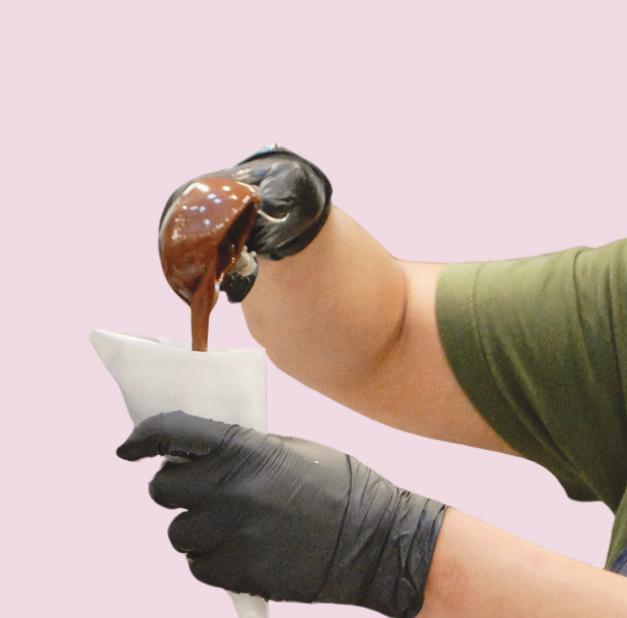



e main co ee shop and storefront at Katherine Anne Confections opens to a one-room production area where K-pop music and chocolate churn in temper and tempo. e production calendar hung on the fridge features the above avors, along with relevant inventory and timetables.
I spent the day in Irving Park with the production team — Kat, Mary, Elena, and Caroline — as hundreds of chocolates were being made. In the a ernoon, I sat down with the owner Katherine to hear more about the story of this unique conserie, the British word for a “candy store.”

Specializing in confections cra ed with unique and powerful avor combinations, Katherine Anne Confections rst opened as a small online business in 2006 and has expanded to two locations in Armitage and Irving Park, opened in 2012 and 2023 respectively. In addition to packaged gi able collections, the shop serves tru es, ganaches, drinking chocolate, gourmet marshmallows, caramels, and specialty lattes. Most of the production happens at the Irving Park location, where Kat and Katherine design weekly tru es, monthly ganaches, and specialty co ee syrups to t their rotating seasonal themes. During my visit, the team was designing tru es for their Mother’s Day Collection and prepping an exclusive potato chip to ee for an upcoming local market.
Here, the stages of chocolate cra ing ow simultaneously. ough the team is small, there are dozens of trays in the kitchen, each holding 150-200 confections. Each ganache is individually enrobed and hand decorated, so the volume of production itself is a testament to the tightly-knit team’s lively dynamic. eir entire operation runs like a tightly-oiled machine: in the back of the house, while Kat tempers chocolate and teaches me how to fold parchment cones, Mary nishes up a brown butter ganache and starts a strawberry balsamic lling. In the front of the house, Kimberly passes through and grabs packages for delivery on her way to a sustainability talk for vendors in the area.
range of 175+ avor combinations is made possible by their sustainable practices. Having grown up making caramels and chocolates on her family’s farm, sourcing locally was an obvious choice. In her 18 years of experience, Katherine has partnered with over 50 local vendors and established longstanding partnerships with Chicago-based companies like Honey Hill Farms and Koval Distillery. As a result, the shop focuses on using real ingredients, utilizing reusable materials like piping bags when possible, and sourcing local in-season produce including fruits, herbs, and vegetables when fresh. e shop then batch freezes these fruits and vegetables to keep their produce viable all year as they continually develop new avors.
When it comes to developing and decorating specialty chocolates, Kat says that it is o en a spontaneous process. She keeps a notebook with base recipes which she then tweaks based on the texture and intensity of speci c avors. Recently, the team has been experimenting with double layered ganaches, which will be featured in the upcoming collection including combos like the goat cheese/red currant bon-bon and the tarragon caramel/chocolate red wine bon-bon. Despite the complexity of avor pro les, developing and producing a avor can take as little as 2 days, though Katherine says that many take much longer. Once the avor pro les are decided, polycarbonate molds are decorated with custom colors of luster dust and then painted, swiped, or speckled with a high chroma colored cocoa butter. From there, the molds are lled, placed on the shaker table to remove air pockets, rmly inverted over the vat of the remaining tempered chocolate to leave a thin shell, and then le to set before being lled with ganache and capped in a nal layer of chocolate. Since the decorative cocoa butters are pre-tempered, they set simultaneously with the chocolate shell, leaving a glistening, nearly re ective surface once released from the mold.





Speaking on sustainability, Katherine Duncan, the founder and owner, said that as a small business,



Born from a team of women who each came from a career outside of chocolate, these beautiful small bites re ect creativity in every dimension, from design to avor pro le. Stop by this con serie for a sweet and delicate treat to pair with a lemon fennel or rosemary caramel latte. If you cannot make it to one of their storefront locations, nd the team at local farmers markets, tasting events, and pop-ups for creatives throughout


Chicago, bringing their same smiles to pair with new avors every week.



What came first: the chicken or the egg? If you ask any foodie, they’ll likely tell you it was the egg — it’s the original breakfast staple, after all. As college students though, buying weekly groceries is all about making the most of your items, which means it’s time for eggs to break out of their breakfast bubble and rise to the occasion of more exciting meals (but don’t worry, we won’t be leaving breakfast completely behind). In these three “recipe vignettes,” we’re ditching all things scrambled, hardboiled, or even folded into an omelet and seeing what else that carton in your fridge is capable of. While two of these three recipes are single servings, feel free to double, triple, or quadruple the recipe to feed your roommates, significant others, and friends.
prep 10 minutes
cook 7 minutes
makes 1 serving
GET
1 slice sourdough bread
1/2 avocado
1/3 cup sprouts
Salt and pepper, to taste
1 egg
DO
½ tsp olive oil Everything Bagel seasoning, to taste (optional)
1. In a small skillet, drizzle a bit of olive oil in the middle of the pan and, using the handle, tilt the skillet side-to-side to ensure the oil has thoroughly covered the bottom before placing it on the stove at medium heat.
2. Crack the egg directly onto the pan. Continue to let the egg cook until it has reached your desired level of doneness (the crispier the edges, the better!). Turn off the stove and allow the egg to cool.
3. Toast your sourdough to your desired level.
4. Using a spoon, scoop out the avocado half from the peel and place it in a bowl. Using a fork, mash the avocado until it reaches a guacamole-like consistency (chunky, but spreadable).
5. Transfer the avocado to the piece of toast, using the fork to ensure the avocado is thoroughly covering the bread.
6. Sprinkle the sprouts on top of the avocado and, using a spatula, transfer the egg from the pan to your toast.
7. Sprinkle with salt, pepper, and everything bagel seasoning to taste. Slice the toast in half or enjoy in one piece.



prep 30 minutes
cook 7 minutes
makes 1 servings
¼ cup uncooked pearled farro, rinsed
1 ½ cups water ½ tsp salt � cup shredded carrots
¼ cup cucumber, cubed
2 kale leaves, chopped ¼ chickpeas
1/3 cup sundried tomatoes ½ avocado, sliced Soy sauce, to taste *You can really add any other toppings you see fit!
1. Bring the water to a boil in a saucepan. Add the farro and salt, stir together, and simmer the farro for approximately 20 minutes until it is chewy and tender. Drain the farro and set aside.
2. In a small skillet, drizzle a bit of olive oil in the middle of the pan and, using the handle, tilt the skillet side-toside to ensure the oil has thoroughly covered the bottom before placing it on the stove at medium heat.
3. Crack the egg directly onto the pan. Continue to let the egg cook until it has reached your desired level of doneness. Turn off the stove and allow the egg to cool.
4. Prepare the carrots, cucumber, and kale. Slice the avocado and drain the chickpeas, if necessary.
5. Put the farro in a bowl, then arrange the vegetables and other toppings.
6. Gently place the egg on top. Sprinkle with your favorite seasonings and drizzle with soy sauce.



1. In a medium pot, bring 3 quarts of salted water to a boil.

2. Meanwhile, cut the bacon into ¼ inch strips and fi nely grate the cheese, setting aside a quarter of it for later.
3. Whisk the egg yolks and egg and then stir in the larger portion of cheese. Add pepper and set aside.
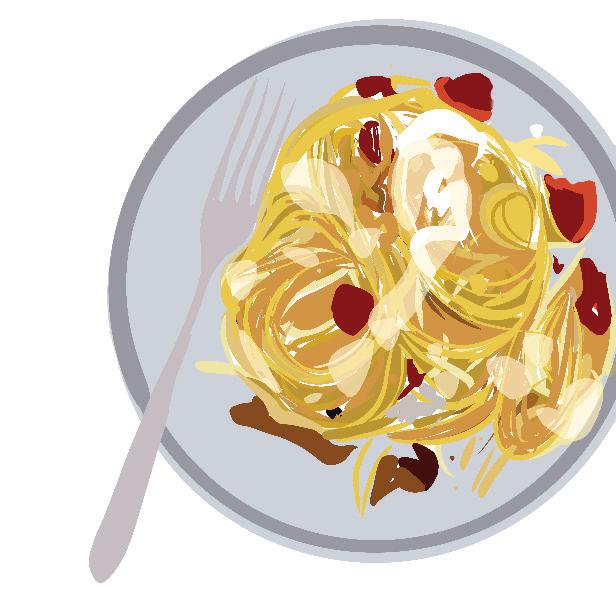
4. In a heavy pot (dutch oven, if you have it!) heat ½ tbsp of oil. Saute the mushrooms, then transfer them to a bowl with a wooden spoon.
5. Add 1 tbsp of oil and then add the bacon, stirring until the edges are crispy, 7-10 minutes.
6. Take the pot off of heat and remove the bacon with a wooden spoon, placing it in the bowl with the mushrooms. Pour the bacon fat into a heatproof measuring cup and measure 2 tbsp to put back in the pot. Discard the remaining fat.
7. Cook your pasta in the boiling water and stir occasionally. When it is almost done, remove a little more than 1 cup of pasta water and add ½ to the heavy pot/dutch oven. Bring that to a boil on medium heat and drain and transfer the pasta to the dutch oven.
8. Stir the pasta, water, and bacon fat constantly and vigorously until the water has reduced to half its original volume (this should take about 2 minutes). Take the pot off heat.
9. Whisk ¼ cup of the reserved pasta water into the egg mixture from step 3, then very slowly put it into the heavy pot, stirring constantly, until cheese is melted and egg is thickened to form a glossy sauce.
10. Season with salt, if needed. Add the remaining ¼ cup pasta cooking liquid, adding a splash at a time, until it's the consistency of heavy cream (it’s okay if you don’t use all of it).
prep 10 minutes cook 12 minutes makes 2 servings
1 ½ tbsp kosher salt, plus more 2 oz. bacon
1 oz. parmesan cheese
½ cup mushrooms, sliced
2 egg yolks
1 egg
1 ½ tbsp olive oil ½ lb spaghetti
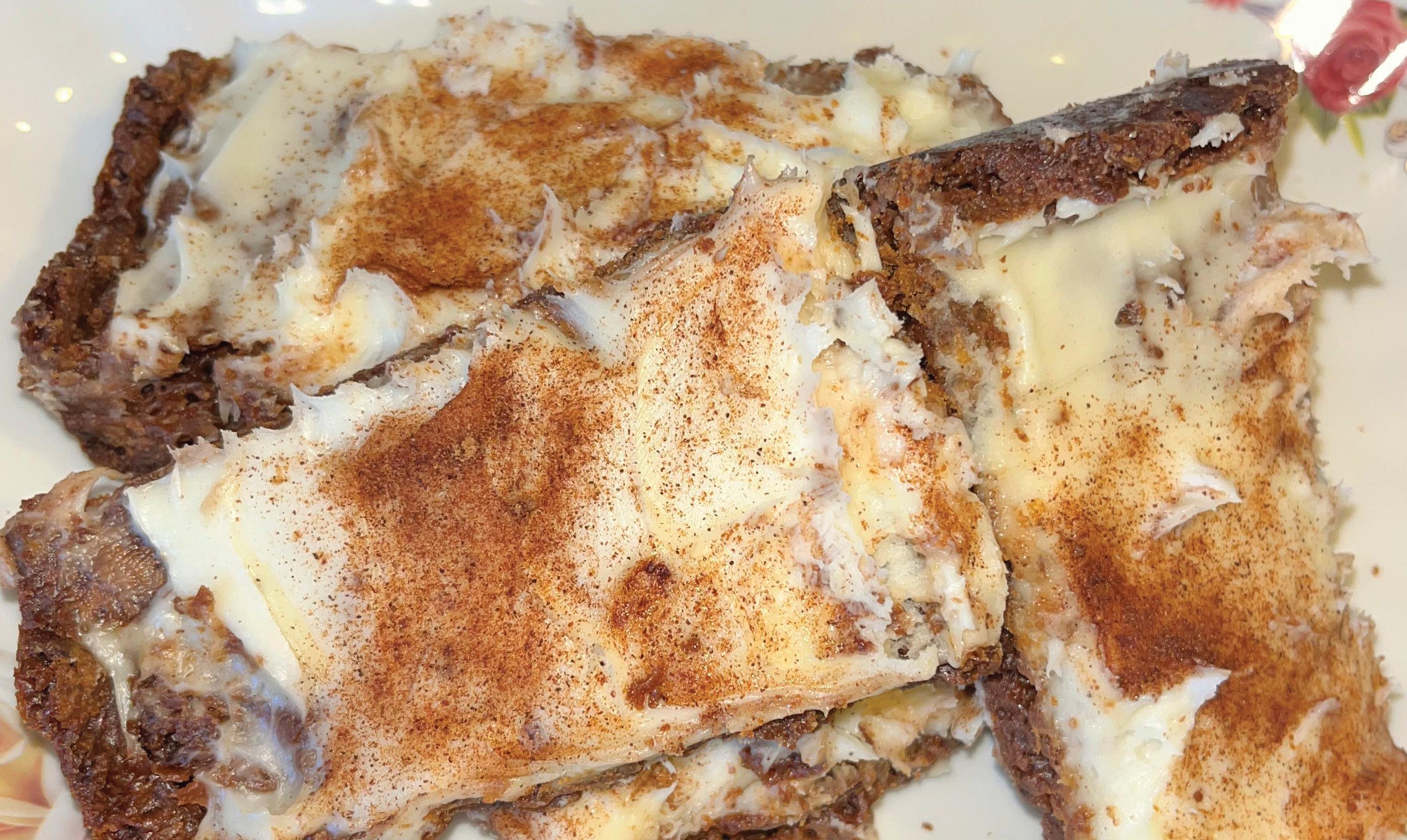 BY KALLIE HOFFMAN
BY KALLIE HOFFMAN
prep 20 minutes cook 25 minutes makes 8-10 servings
Bars
2 cups all-purpose flour
2 tsp ground cinnamon
1 tsp baking powder
1/4 tsp baking soda cups brown sugar
2/3 cup butter
2 eggs
2 tsp vanilla
Topping
12 oz. tub vanilla buttercream frosting
¼ cups granulated sugar
1 tsp cinnamon
The sweet taste of snickerdoodle is an underrated flavor that has weaseled its way into the hearts of dessert lovers everywhere. These bars are easy to make, require few ingredients, and are the perfect snack for any occasion. Who doesn’t adore the light and tangy taste of a sugary snickerdoodle treat? Not to mention, these bars are coated with creamy vanilla frosting and a generous topping of cinnamon, which provides a nice complement to the chewy texture of the gooey inside. The aroma that fills the kitchen as these bars bake is enough to make mouths water from rooms away, and each bite will deliver a delightful combination of buttery richness and comforting spice. Whether enjoyed with a cup of coffee or as a late night snack, these frosted snickerdoodle bars are exactly what you need to satisfy your sweet tooth. After all, who can resist the allure of a classic snickerdoodle reinvented into a delicious bar form? So, gather your ingredients, preheat the oven, and whip up a dessert that is bound to become your go-to treat.
For the bars:
1. Preheat the oven to 350 F and line a 9x9-inch baking pan with foil.
2. Grease the foil and set the pan aside.
3. In a medium bowl, stir together flour, 2 tsp cinnamon, the baking powder, and baking soda. Set aside.
4. In a medium saucepan, cook and stir brown sugar and the 2/3 cup butter over medium heat until butter is melted. Remove from heat and cool slightly.
5. Mix in the eggs and vanilla. Slowly pour in the flour mixture until smooth.
6. Pour batter into the prepared baking pan.
7. Bake for 25 to 30 minutes and leave out to cool.
For the topping:
1. In a small bowl, stir together granulated sugar and 1 tsp cinnamon.
2. Coat the bars with vanilla frosting.
3. Sprinkle the sugar and cinnamon on top until frosting is covered.
4. Cool completely before cutting into bars.
5. Enjoy!

This recipe is a testament to how far fusion cuisine can go. I developed this recipe because of my love of carne asada and my interest in experimenting with odd combinations. Because my friend is half-Romanian, I asked her if she had any family recipes. She suggested Musaka, which is a three-layered dish of tomato sauce, ground meat, and potatoes. I recently bought flank steak for carne asada and decided to merge the two ideas. Thus, my version is a baked dish consisting of fresh salsa, citrusy carne asada, and crispy potatoes, all topped with creamy cheese. The complexity of this dish comes from all the separate parts that need to be made first, but the assembly is quite simple. Rest assured, you are bound to like this dish, which is an interesting and unique take on comfort foods from two different parts of the world.
prep 1 day to 1 hour to marinate steak cook 50 minutes makes 5 servings
2 lbs flank or skirt steak
4 limes worth of juice
1 large red onion
4 Roma tomatoes
1 1/2 tbsp chili powder
2 tbsp soy sauce
2 tbsp olive oil
8 cloves garlic
2 tsp salt
2 tsp pepper
¼ cup of cilantro
1 jalapeno
4 Chile de Arbol
5 large potatoes
1 cup of Mexican shredded cheese
For the salsa:
1. Preheat the oven to 375°.
2. Cut Roma tomatoes, jalapeno, red onion, and 4 garlic cloves and place on a roasting sheet.
3. Drizzle with 2 tbsp olive oil.
4. Roast for 35 minutes or until slightly blackened.
5. Chop and add cilantro leaves and chile de arbol.
6. Blend into salsa in either a blender or food processor.
For the carne asada:
7. Mix soy sauce, 2 tbsp olive oil, chili powder, lime juice, salt and pepper.
8. Pour into ziplock bag with flank steak.
9. Let marinate for at least an hour, preferably a day.
10. Cook in a cast iron skillet, 4
minutes on each side until 137° internal temperature.
11. Chop into bite-sized pieces.
For the potatoes:
12. Boil water and add ¼ teaspoon salt.
13. Skin potatoes and place whole into pot.
14. Let boil for 30 minutes or until tender.
15. Slice into discs.
For the assembly:
16. In a casserole dish, spread salsa on the bottom in a thick layer.
17. Distribute carne asada pieces evenly.
18. Top with potato slices until everything is covered.
19. Spread Mexican cheese on top.
20. Bake for 30 minutes.

prep 60 minutes
cook 30 minutes makes 1 serving
BY CONNOR BLOCH PHOTOS BY EMILY KIM GETFor tomato concasse
5 roma tomatoes
For sauce vierge
125 grams tomato concasse
15 grams champagne vinegar
5 grams shallots, minced
35 grams extra virgin olive oil
2 sprigs of chopped tarragon
2 sprigs of chopped thyme
Kosher salt to taste
For roasted zucchini
3 zucchini, green and/or yellow
6–8 oz. neutral-flavored plant-based oil
Vierge sauce
Kosher salt
Finishing salt
For seared red snapper
Seared Red Snapper
1 filet of red snapper
2 cloves garlic, crushed with peel still on 4 tbsp butter
2-4 oz. neutral-flavored plant-based oil
2 sprigs tarragon
4 sprigs of thyme
Salt and pepper



Popularized in the 1980s by French chef Michel Guérard, Sauce Vierge, translated as “virgin sauce,” has quickly become a staple of nouvelle cuisine. Nouvelle cuisine, a rejection of the butter-heavy dishes of haute cuisine which most typically associate with French food, is a more modern approach consisting of lighter flavors and more elevated plating. This springtime recipe highlights seasonal ingredients we will find in grocery stores as we get closer to spring and summer. Through the fusion of a light fish with vinegar and lemon juice which bring out acidity, this dish is full of bright flavors and sure to wow anyone you make it for. Don’t forget the herbs, as they bring a depth of flavor and elevate this dish to new heights!
1. Place the zucchini on the plate in the upper right portion of the plate at a slight angle.
2. Th en spoon the vierge sauce over the top of the zucchini.
3. Place the fi sh, skin-side up, next to the zucchini.


Sprinkle fi nishing salt (fl aky salt) and lemon





For the tomato concasse
1. Boil a pot of water.
2. Make a shallow incision about ½ in. in length across the butt of the tomato.
3. Rotate 90° and make another cut, forming an X.
4. Get a bowl of ice water and place it next to the pot on the stove.
5. Drop in your tomatoes, letting them boil for roughly 90-120 seconds.
6. Take them out of the pot and place them in the ice water.
7. After they cool in the water, peel and quarter the tomatoes.
8. Remove the seeds and perform a small dice of the tomatoes
For the sauce vierge
For the roasted zucchini




9. Combine all the ingredients in a mixing bowl, allowing time for the fl avors to blend together.

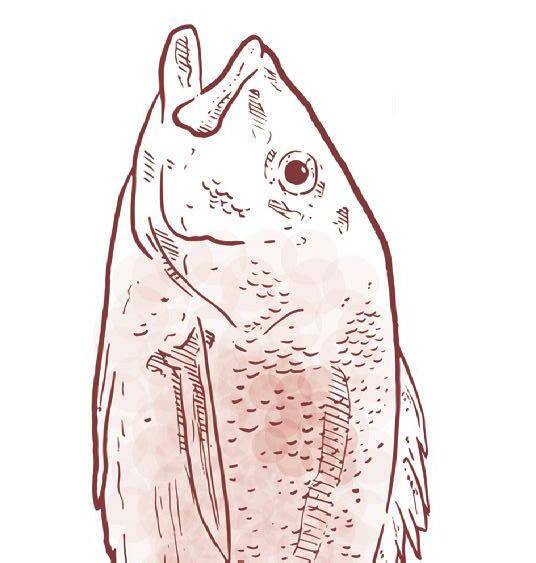
12. Leave the zucchini for 10–15 minutes so that salt has time to draw out moisture.
13. Pat the zucchini dry.

10. Halve the zucchini lengthwise and score the fl esh in a crosshatch pattern so that the salt can penetrate it.

11. Sprinkle salt onto the scored side of the zucchini from a height that allows it to evenly distribute (roughly 6-8 inches above).
14. Heat canola oil over medium-high heat (use just enough to coat the bottom of the pan) in a 12-inch fry pan (I like to use cast iron) until it’s shimmering and just beginning to smoke.



15. Add the zucchini fl esh side down in the oil, adjust the heat to allow the zucchini to sear and caramelize without burning.


16. Cook for about 5 minutes, then add herbs or garlic, fl ip the zucchini, and immediately place the pan in a 450°F oven to roast for 15 minutes.
18. Transfer zucchini to a paper towel–lined plate to blot excess oil.
For the seared red snapper
20. Season the fl esh of the fi sh with salt and pepper.

17. Flip the zucchini and continue roasting for another 10-15 minutes or until the zucchini are completely soft.
19. Heat canola oil over medium-high heat (use just enough to coat the bottom of the pan) in a 12-inch fry pan (I like to use cast iron) until it’s shimmering and just beginning to smoke.

21. Th oroughly dry the skin of the fi sh before placing in the pan, as moisture will prevent the skin from crisping up.



22. Place the fi sh skin-side down and cook until the skin crisps, you will know when this occurs because the fi sh will unstick from the pan. If it is still stuck, it is not done yet so don’t move it as this can damage the skin.

23. Once ready, turn down the heat to medium low, fl ipping the fi sh and adding the butter, garlic, and herbs. Make sure to dry the herbs off well after washing, as they will splatter if there is residual water still on the leaves.

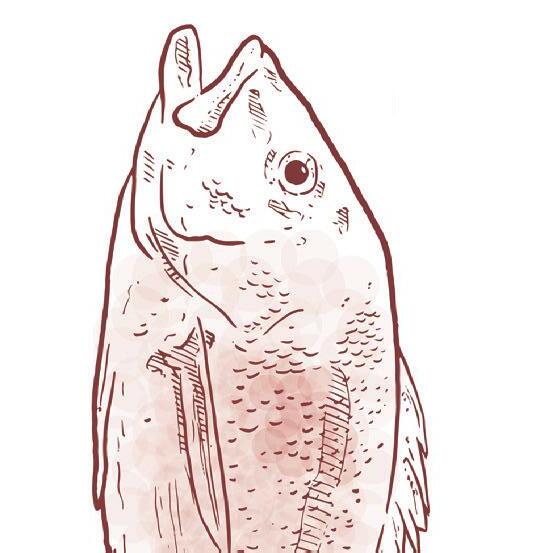

24.

25.

26.







Once lightly seared on the fl esh side, fl ip, so the fi sh is skin-side down once again. Begin spooning the butter, herbs, and garlic over the fl esh of the fi sh, adding their fl avor. Once cooked through, about 5-6 minutes depending on the thickness of the fi sh, place on a wire rack skin-side up to rest.





